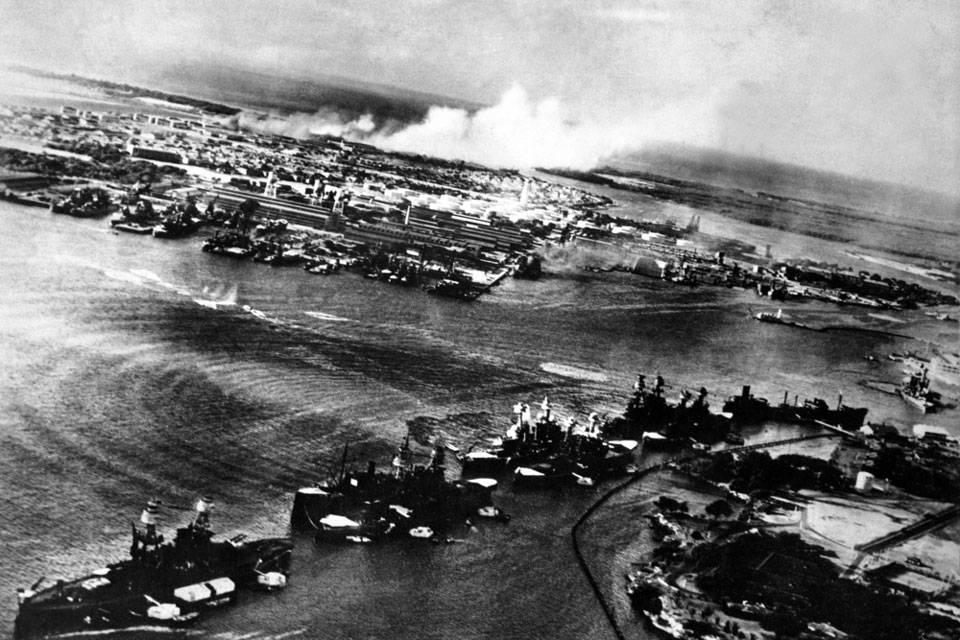Exploring History’s Most Impactful Surprise Offensives

Delving into the annals of military history, one can uncover accounts of momentous surprise attacks that left an indelible mark on the course of events. These instances of strategic traps, unexpected assaults, and well-executed ambushes have significantly shaped the narrative of history.
In the quest to pinpoint history’s most significant surprise attacks, various sources, including History Collection, War History Online, Military History Now, NPR, Historic UK, Historynet, and Britannica, were consulted. These offensives often carried profound historical weight, altering the course of wars. While this compilation does not claim to encompass every noteworthy surprise attack, it provides a glimpse into many renowned and historically impactful ones. The chronology of these battles reflects the order in which they transpired.
Many of these surprising assaults were orchestrated by nations or political movements that were underestimated by their adversaries. Notable examples include the Continental Army, led by General George Washington, stunning Hessian mercenaries in Trenton, New Jersey, on Christmas Day in 1776, thereby injecting crucial morale into the fledgling nation. Fast forward nearly two centuries, and the perception that communists in South Vietnam were a weakened force was shattered by the Tet Offensive in 1968, revealing the tenacity of the enemy and challenging the belief in the winnability of the war to the American public.
- Battle of Megiddo
Date: 1457 BC
Location: Megiddo (present-day Israel)
Opponents: Egypt, Canaanite rebels
Pharaoh Thutmose III of Egypt and his forces engaged Canaanite rebels in a revolt centered around Megiddo in present-day Israel, a pivotal trade route between Mesopotamia and Egypt. Facing a strategic decision, Thutmose chose the shorter central route, relying on the geographical challenges to surprise the Canaanites, successfully ending the rebellion. - Battle of Salamis
Date: Sept. 26-27, 480 BC
Location: Island of Salamis
Opponents: Greek city-states, Persian Empire
In the naval confrontation near Salamis in the fifth century BC, the Greek city-states executed one of history’s remarkable surprise attacks. Despite being outnumbered two-to-one by the Persian navy, the Greeks, under the leadership of Themistocles, concealed a portion of their fleet, waiting for an opportune moment. As the Persian fleet entered the strait, the Greeks emerged, devastating the less-maneuverable Persian ships and sinking around 300, while losing a mere 40 of their own. This naval triumph delayed Persian land offensives, allowing the Greek city-states to unite against Xerxes. - Battle of Lake Trasimene
Date: June 24, 217 BC
Location: Lake Trasimene, Umbria region, Italy
Opponents: Rome, Carthage
Guided by the brilliant general Hannibal during the Second Punic War, a Carthaginian army advanced southward to Lake Trasimene in Italy, achieving a monumental tactical triumph. Hannibal orchestrated a trap for the Roman forces led by General Gaius Flaminius, strategically employing smaller units to engage and withdraw. In a narrow passage with Lake Trasimene on one side and a forest on the other, the Carthaginians, emerging from the fog-covered woodland, caught the Romans off guard. Resulting in the death or capture of half the Roman legions, this battle marked one of Hannibal’s greatest victories. - Battle of Teutoburg Forest
Date: September 9
Location: Kalkriese, present-day Germany
Opponents: Rome, Germanic tribes
The devastating defeat of three Roman legions in the Teutoburg Forest stands as a staggering blow to the Roman Empire’s history. In the first century, Rome sought to subdue the Germanic regions, assigning commander Publius Quinctilius Varus to quell the rebellion. Arminius, a Roman-educated German vassal, deceived Varus with false rebellion information. As the legions traversed narrow forest paths, they faced relentless attacks from Germanic tribes, resulting in the annihilation of the legions and Varus’s suicide. This impactful defeat not only halted the Roman Empire’s northward expansion but also contributed to enduring cultural distinctions between northern and southern Europe. - Sacking of Rome
Date: Aug. 24, 410
Location: Rome
Opponents: Rome, Visigoths
With Rome’s military grandeur reduced to a distant memory, Visigoth King Alaric I achieved an unprecedented feat. Collaborating with rebellious slaves, his army breached Rome’s gates and pillaged the city. The famine-stricken Rome, spared in churches due to the Christian faith of many invaders, witnessed the destruction of pagan temples and governmental structures. Although the empire persisted, the sacking of Rome dealt a profound psychological and political blow to the once-invincible realm. - Battle of Pliska/Vărbitsa Pass
Date: July 26, 811
Location: Bulgarian countryside
Opponents: Byzantine Empire, Bulgaria
Weary of the perceived troubles caused by Bulgarian forces under warlord Krum, Byzantine Emperor Nikephoros led an 80,000-strong army into Bulgaria. Despite Krum’s plea for peace, Nikephoros rejected it and razed the Bulgarian capital, Pliska. The Bulgarians, devising an ambush, exploited the Vărbitsa Pass, a mountainous route 3,000 feet above sea level in the Balkan Mountains. Traps, walls, and a wooden barricade hindered the Byzantine advance, sealing their fate. Blocked both in the pass and the valley exit, almost the entire Byzantine army, including Nikephoros, fell victim to the Bulgarians’ deadly strategy. - Battle of Stamford Bridge
Date: Sept. 25, 1066
Location: Stamford Bridge, England
Opponents: Anglo-Saxons, Norsemen
Preceding his defeat at the Battle of Hastings against William the Conqueror, King Harold, the final Anglo-Saxon king of England, successfully repelled a Norsemen invasion. While anticipating a Norman invasion from the south, Harold learned of Norsemen landing farther north. Marching his 15,000-strong army 200 miles to Stamford Bridge, Harold took the Norsemen by surprise, leading to the death of thousands. Despite this victory, Harold’s triumph was short-lived, as he later succumbed to William the Conqueror, who seized the English throne. - Battle of Medway
Date: June 9, 1667
Location: River Medway, England
Opponents: England, Netherlands
In the 17th-century struggle for maritime supremacy between England and the Netherlands during the Second Anglo-Dutch War, the Dutch dealt a severe blow to the Royal Navy in English waters in the Battle of Medway. Executing a plan by political leader Johann de Witt, the Dutch captured the English seaport of Sheerness and navigated the challenging River Medway, destroying a protective iron chain. They wreaked havoc on 13 Royal Navy ships at Gillingham and Chatham ports, taking advantage of England’s weakened naval defense after the plague and the Great Fire of London. Adding insult to injury, the Dutch seized two English ships, including the flagship HMS Royal Charles. - Battle of Trenton
Date: Dec. 25, 1776
Location: Trenton, New Jersey
Opponents: American colonies, England
Amidst a bleak period for the American colonial forces in 1776, General George Washington devised a daring plan to attack Britain’s Hessian mercenaries in Trenton. Crossing the Delaware River on Christmas night, the Continental Army launched a surprise assault, resulting in the capture or death of all Hessian troops. Although a morale boost for the army and the nascent nation, ultimate victory remained five years away. - Grierson’s Raid
Date: April 17, 1863
Location: Mississippi
Opponents: Union, Confederacy
Colonel Benjamin Grierson, an unconventional figure with a background in music teaching and a dislike for horses, led a bold Union raid in April 1863. Departing from La Grange, Tennessee, with 1,700 horsemen, Grierson ventured deep into Mississippi behind Confederate lines. The raid involved the destruction of bridges, sabotage of railroad tracks, and wreaking havoc across the state. Grierson’s audacious exploits not only earned him recognition but also played a crucial role in General Ulysses S. Grant’s successful Vicksburg Campaign, boosting the morale of Union cavalrymen who had previously been overshadowed by their Confederate counterparts. - Battle of Chancellorsville
Date: May 2-4, 1863
Location: Chancellorsville, Virginia
Opponents: Union, Confederacy
General Robert E. Lee’s triumph at the Battle of Chancellorsville, amid being outnumbered two-to-one by Union forces under Major General Joseph Hooker, stands as one of his most remarkable victories during the Civil War. Defying military conventions, Lee and Lieutenant General Thomas J. “Stonewall” Jackson divided their troops into two units. Jackson, executing a 12-mile march on back roads, surprised the Union army’s right flank, leading to a Confederate victory. However, this success came at a cost, as Jackson fell victim to friendly fire and succumbed a week later. - Battle of Aqaba
Date: July 6, 1917
Location: Aqaba, Jordan
Opponents: Arabs, Ottoman Empire
In a daring maneuver during WWI, about 5,000 Arab cavalry, led by Sherif Nasir and Auda abu Tayi and advised by English Captain T.E. Lawrence, crossed the Nefud desert to unexpectedly seize Aqaba, Jordan, from Ottoman Empire forces. This victory not only relieved pressure on British forces in Palestine but also opened a strategic route towards capturing Jerusalem and Damascus. The success of the Arab forces, guided by Lawrence, contributed to the legend of “Lawrence of Arabia,” captivating the British public through newspapers, books, and movies. - Attack in the Ardennes Forest
Date: May 16, 1940
Location: Ardennes, Belgium
Opponents: Allies, Axis Powers
Despite France’s triumph over Germany in WWI, lingering fears prompted the French to construct the Maginot Line, an extensive defensive network, between the wars. Positioned on the border with Germany, the line aimed to counter a potential German attack through Belgium. However, on May 10, 1940, the Germans defied expectations by invading the Low Countries. Six days later, mechanized armor broke through the Ardennes Forest in southern Belgium and Luxembourg, previously thought impassable for tanks. This strategic move cut off Allied troops in northern France and Belgium, leading to France’s capitulation six weeks later. - Operation Judgment
Date: Nov. 11-12, 1940
Location: Taranto, Italy
Opponents: Allies, Axis Powers
Operation Judgment, a British aerial attack during WWII, targeted the well-fortified Italian fleet at the naval base in Taranto. Launched from the aircraft carrier HMS Illustrious, 21 obsolete Swordfish biplane torpedo bombers surprised the Italians, catching them off guard. The attack, the first of its kind from aircraft carriers against heavily defended warships, resulted in significant losses for the Italian fleet. The success of Operation Judgment shifted the balance of power in the Mediterranean in favor of Great Britain and drew attention from other nations, including Japan. - Operation Barbarossa
Date: June 22, 1941
Location: Soviet Union
Opponents: Axis Powers, Soviet Union
Despite a non-aggression pact in 1939, Adolf Hitler’s disdain for communism and desire for Soviet territory led to Operation Barbarossa. Launched on June 22, 1941, this colossal land invasion involved three million German troops, marking a pivotal moment in history. Initially disbelieving the invasion, Soviet dictator Joseph Stalin saw the collapse of the weakened Soviet army, resulting in over six million military casualties and countless civilian deaths in the first six months. The invasion stalled during Russia’s harsh winter, and the superior Russian numbers and supplies ultimately overcame the Nazi forces. - Pearl Harbor
Date: Dec. 7, 1941
Location: Pearl Harbor, Hawaii
Opponents: U.S., Japan
The escalating tensions between the United States and Japan in the 1930s, exacerbated by Japanese expansion into China and a U.S. oil embargo, reached a critical point when Japan sought to invade oil-rich areas in the South Pacific. Facing the need to eliminate the U.S. Pacific fleet, Japanese airplanes launched a surprise attack on Pearl Harbor on Dec. 7, 1941. Sinking four battleships and damaging several others, along with causing significant casualties and destroying numerous airplanes, the attack propelled the United States into WWII. - Doolittle Raid
Date: Apr. 18, 1942
Location: Tokyo, Japan
Opponents: U.S., Japan
In response to the Pearl Harbor attack, President Franklin D. Roosevelt aimed to boost American morale by bombing Japan. Facing the challenge of lacking airbases within range, the innovative solution involved using an aircraft carrier, the USS Hornet, as a floating airbase for B-25 bombers. Led by U.S. Army Air Corps Lieutenant Colonel James Doolittle, 16 B-25s took off 750 miles east of Japan on April 18, 1942, successfully bombing Tokyo. Though causing limited physical damage, the raid had a profound psychological impact, uplifting American morale and surprising the Japanese. - D-Day (the Normandy Invasion)
Date: June 6, 1944
Location: Normandy, France
Opponents: Allies, Germany
Officially known as Operation Neptune, the Allied invasion of Normandy in northwestern France, commonly referred to as “D-Day,” marked a pivotal step in liberating France and Western Europe. Despite German anticipation, a deceptive plan, Operation Bodyguard, orchestrated by the British war department, misled them about the attack’s date and location. On June 6, 1944, around 24,000 American, Canadian, and British troops landed along a 50-mile stretch of the coastline, catching an unprepared German force. Despite heavy Allied casualties, the invasion initiated the Allied victory on the Western Front, significantly impacting the Nazi war machine. - Battle of the Bulge
Date: Dec. 16, 1944-Jan. 25, 1945
Location: Ardennes, Belgium
Opponents: Allies, Germany
Approaching the end of 1944, the Western Allies, positioned on the German border, were ready to deliver the decisive blow against the Nazi regime. Adolf Hitler devised an offensive plan, targeting the Ardennes Forest, where the Germans had launched a surprise attack on France four years earlier. Hitler aimed to cut through a vulnerable section of the Allied lines, divide the American and British armies, and compel a separate peace from the Western Allies and the Soviet Union, perceived as the true adversary.
On Dec. 16, 1944, 30 German divisions breached thinly held positions manned by inexperienced American troops. Overcast conditions neutralized Allied air superiority, allowing the Germans to form a bulge in the Allied line. When weather conditions improved, Allied air forces struck, and General George Patton’s Third Army moved northward to relieve beleaguered troops in Belgium. Hitler’s gamble failed, likely hastening the war’s end. The U.S. suffered 100,000 casualties, making it America’s bloodiest battle in WWII. - Battle of Asal Uttar
Date: Sept. 10, 1965
Location: Asal Uttar, India
Opponents: India, Pakistan
Since gaining independence in 1947, India and Pakistan, bitter enemies, clashed over the disputed area of Kashmir. In 1965, fueled by U.S. military aid, Pakistan sought to seize Kashmir, capitalizing on India’s recent military defeat against China. Invading on Sept. 8, 1965, Pakistan captured a village over the internationally recognized border. Indian troops lured Pakistani mechanized units into a trap, resulting in the destruction or capture of 100 Pakistani tanks compared to 10 Indian tanks. This battle became one of the largest tank engagements since WWII. - Operation Focus
Date: June 5, 1967
Location: Egypt, Syria, Jordan
Opponents: Israel, coalition of Egypt, Syria, and Jordan
Faced with stalled diplomatic negotiations and anticipating a coordinated invasion, Israel opted for a pre-emptive strike with Operation Focus on June 5, 1967. The Israeli forces targeted the Egyptian air force, destroying 500 planes on the ground and rendering airstrips unusable. Over the next five days, the Israeli air force neutralized the Jordanian and Syrian combat aircraft. While Israel’s victory in the Six-Day War shocked the world, it did not resolve tensions with its Arab neighbors, who would launch another attack six years later. - Tet Offensive
Date: Jan. 30, 1968
Location: Coordinated assaults in South Vietnam
Opponents: U.S. and South Vietnam, Viet Cong
Despite the belief in imminent victory over North Vietnam and the Viet Cong by the end of 1967, the United States and its South Vietnamese ally faced a colossal miscalculation. The North Vietnamese and Viet Cong orchestrated the Tet Offensive, commencing on the Vietnamese New Year. Surprise attacks targeted military installations in five provincial capitals, including Saigon. The Tet Offensive, lasting eight months, saw the Americans and their allies repel the insurgents, resulting in the loss of 100,000 Viet Cong troops. - Yom Kippur War
Date: Oct. 6, 1973
Location: Israel
Opponents: Israel, Egypt and Syria
Seeking retribution for the humiliating Six-Day War defeat in 1967, Egypt and Syria orchestrated an attack against Israel on Oct. 6, 1973, during Yom Kippur, the holiest day in the Jewish calendar. Exploiting the absence of many Israeli soldiers observing the day of atonement, Egyptian and Syrian forces initiated a coordinated assault. While Egyptian troops, equipped with modern Soviet weapons, advanced into the Sinai Peninsula, Syria aimed to dislodge Israeli forces from the Golan Heights. In response, Israel counterattacked and reclaimed the Golan Heights. A ceasefire was established on Oct. 25, 1973.
Despite Egypt’s ultimate defeat, President Anwar Sadat’s stature rose due to the initial success. Utilizing this newfound prestige, Sadat brokered the first peace accord between Israel and its Arab neighbors. However, other Arab nations ostracized Sadat, and his peace initiatives eventually led to his assassination. - World Trade Center Attack
Date: Sept. 11, 2001
Location: New York City
Opponents: United States, al-Qaeda
On Sept. 11, 2001, 19 Islamic militants associated with the extremist group al-Qaeda hijacked four airliners, executing suicide attacks against U.S. targets. Two planes collided with and destroyed the twin towers of the World Trade Center in New York City, a third crashed into the Pentagon in Arlington, Va., and the fourth, believed to target Washington, D.C., crashed in a Pennsylvania field after passengers thwarted the hijackers. The attacks resulted in the loss of almost 3,000 lives.
While prior terrorist incidents had occurred, the events on 9/11 were deemed acts of war. In October, the U.S. and its allies initiated Operation Enduring Freedom to oust the Taliban regime in Afghanistan, where the attacks were planned, and dismantle Osama bin Laden’s terrorist network. The Taliban were removed from power within two months, yet insurgency persisted in Afghanistan for years, culminating in the Taliban’s retaking of the country in 2021 following the final departure of American troops.
Have you read?
The world’s largest economies in 2023.
Ranked: Safest Countries in the World, 2023.
Countries With the Most Female Billionaires, 2023.
Economy Rankings: Largest countries by GDP, 2023.
The Global Passport Index: The World’s Most Powerful Passports.
Richest countries in the world by GDP per capita in 2023.
Add CEOWORLD magazine to your Google News feed.
Follow CEOWORLD magazine headlines on: Google News, LinkedIn, Twitter, and Facebook.
This report/news/ranking/statistics has been prepared only for general guidance on matters of interest and does not constitute professional advice. You should not act upon the information contained in this publication without obtaining specific professional advice. No representation or warranty (express or implied) is given as to the accuracy or completeness of the information contained in this publication, and, to the extent permitted by law, CEOWORLD magazine does not accept or assume any liability, responsibility or duty of care for any consequences of you or anyone else acting, or refraining to act, in reliance on the information contained in this publication or for any decision based on it.
Copyright 2024 The CEOWORLD magazine. All rights reserved. This material (and any extract from it) must not be copied, redistributed or placed on any website, without CEOWORLD magazine' prior written consent. For media queries, please contact: info@ceoworld.biz
SUBSCRIBE NEWSLETTER








